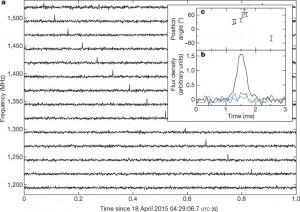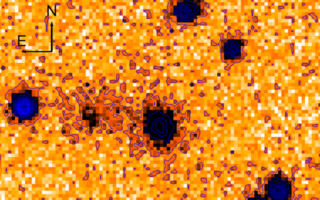Thursday, 25/02/2016. The UTMOST team have been closely involved with the discovery of a Fast Radio Burst host galaxy, published in Nature today. The was lead by UTMOST’s Dr. Evan Keane. Fast Radio Bursts, or FRBs, are unusually bright and brief flashes of radio emission of uncertain origin – until now.
The burst was initially found as part of the SUPERB project running at the Parkes Radio Telescope. SUPERB team members spotted it within minutes of it taking place and sent emails to telescopes all around the world to follow it up.
UTMOST team member Shivani Bhandari, along with Dr. Simon Johnston, head of astrophysics at the CSIRO, used the ATCA radio telescope in Narrabri to make a radio image of a patch of sky within hours of the detection of an FRB with the Parkes Radio Telescope. They discovered a fading radio source for which they were able to give a precise location, after a multi-week campaign and many hours of observations.
A distant galaxy was then identified at this exact spot in images taken with the SUBARU telescope, and a spectrum of the host placed it at a redshift of 0.5, or about 6 billion light years away.
The research team was able to use the combination of the FRB’s and host galaxy’s properties to measure the amount of baryonic matter in the Universe — for the first time directly — obtaining a value in good agreement with previous, indirect determinations. This, in effect, is a means of weighing the Universe. The team found that 5% of the Cosmos is composed of baryons — or “ordinary matter” — the stuff from which people, planets and stars are made.
Fast Radio Bursts are a source of intensive research at UTMOST. Swinburne and Sydney Universities are currently working to transform the giant 18,000 square metre Molonglo telescope into a dedicated Fast Radio Burst finder, as part of Professor Matthew Bailes’ recently awarded ARC Laureate Fellowship.
Congratulations to everyone involved in this great result!
Links
Keane et al, 2016, Nature, 530, 453
http://www.nature.com/nature/journal/v530/n7591/full/nature17140.html
Some of the press coverage

